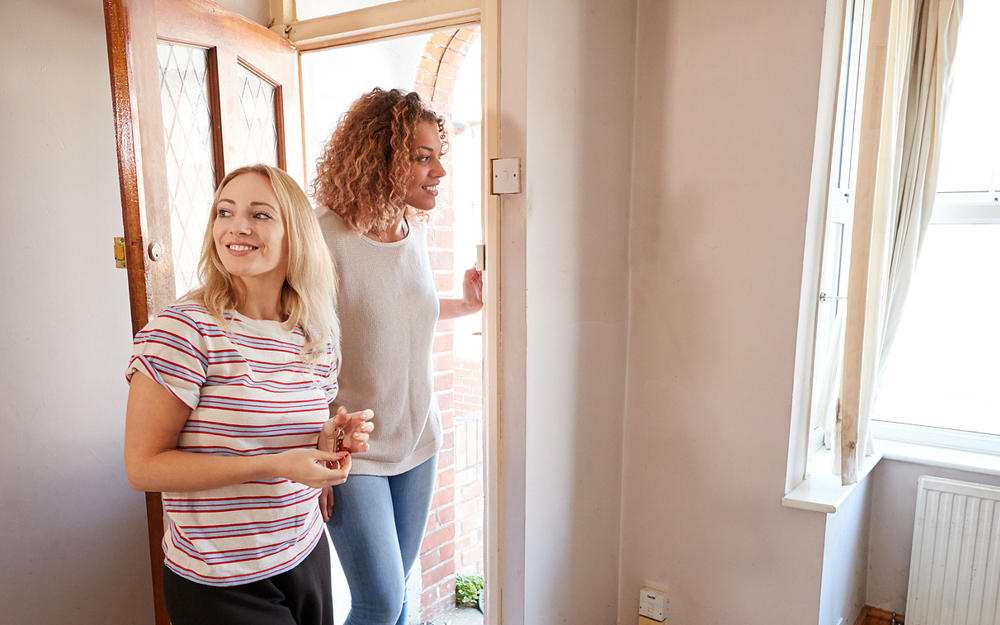ACT’s Professional Advantage: Save $70,000+ in Australia’s Most Stable Market
The Australian Capital Territory offers first home buyers a unique combination of Australia's most stable employment market and strategic...

It’s tempting to put price above everything else when choosing insurance for your property. However, whether you’ve just taken out a new mortgage or are hunting for a better deal, making sure you have enough of the right sort of cover is just as important. Here are the main insurance points to consider when comparing home and contents insurance policies.
Home insurance covers the replacement of your home building and permanent fixtures like plumbing and built-in cabinetry. The most common type is ‘sum-insured’, which will cover an amount that is specified by you when you take out the policy, should you need to repair or rebuild. Some insurers offer ‘total replacement’ cover, which covers the cost to repair or rebuild and replace anything destroyed by the event to the same standard but this is usually much more expensive and so not as popular.
Either way, to avoid being underinsured, you need to work out an accurate rebuild cost. You’ll also need to decide if you want to include extras like accommodation during rebuilding and removing debris from the site.
Most insurers have calculators on their websites. Try to find one based on ‘elemental estimating’. It collects a lot more detail about your home’s construction and location, making it more accurate than the rougher cost-per-square-metre estimates.
It’s often worthwhile checking if an insurer offers an underinsurance buffer. This is when they add up to 30% to your sum-insured amount if your property is a total loss.
Checking exclusions is vitally important, as all household insurance is based around carefully defined events. That means you need to check that a quote’s definitions, especially natural events like ‘flood’ and ‘fire’, work for your location and likely risks.
Most contents insurance offers the replacement value of your belongings, or ‘new for old’ cover but it is possible to find fixed value, or sum-insured policies.
With contents insurance, you need to decide what to include in your cover. You’ll also need to check if an insurer repairs or replaces the damaged items or pays you the amount it would cost to repair or replace them.
To calculate the value of your insurance, you’ll need to make a list of the belongings you want to insure and include how much the items would cost to replace today. You may need to add portable technology like tablets and laptops, specialist items like artwork or things valued above the payout limit, like a large TV, bikes or jewellery, under Extras. Accidental Damage, such as a broken vase or stained carpet, is often included as an optional extra here too.
Keeping serial numbers, purchase receipts and photos of items can help with cost assessment if you need to claim. You can find user-friendly calculators on most content insurance websites. Again, check the definition of the events covered by a policy to make sure it meets your needs and to avoid any unpleasant surprises, in the event you need to make claim.
Landlord insurance is available for long- and short-term tenancy rentals and can include building, contents, and rental income cover.
Try to compare at least three quotes for each type of insurance. They will have Key Fact Sheets and Product Disclosure Statements (PDS) available online.
The main features to compare for any home insurance are;
Also check for discounts on bundling policies, buying online and any safety measures you have adopted. Some may include additional services like replacing locks after a burglary. And while comparison websites can be useful, please remember that they may promote only paying businesses and will not show your full range of options.
While it’s not something we like to think about, minor mishaps and unexpected disasters can arise, so taking your time to select the most appropriate cover for your circumstances can prove valuable in the unfortunate event you need to make a claim.

Why go through the worry (and expense) of moving when you can turn your current place into your dream home? While renovations aren’t always stress-free (or cheap) there are some straightforward ways to finance your property’s facelift, so it suits your post-pandemic lifestyle.
The type of renovation you want and the budget you’ll need will dictate the type of loan required so it pays to plan ahead. If you choose the wrong loan, you could be left with a skip load of unexpected debt.
Tradie comparison site hipages.com.au crunched the numbers in 2021 to reveal that significant home extensions and renovations start at about $100,000 and can cost up to $300,000 for a traditional family home.
Once you have the ballpark budget, then you can decide just how you might finance your home improvement.
Renovation time just might be the perfect opportunity to review your home loan and see if it still works for you. Changing lenders could provide a better rate and additional product features, but you’ll have to pay for the costs of refinancing. Negotiating with your current lender and extending your loan with them may allow you to avoid such costs. Ultimately, if you renovate wisely then you will be increasing the value of your home and the long-term benefits should outweigh any upfront loan costs.
If you’ve been making additional payments on your home loan over time, then redrawing some of the extra money could help fund your renovation. You’ll only be able to use the additional amount you’ve added so you’ll need to ensure it will be enough before redrawing. Just check whether your home loan has a redraw facility and verify whether your lender charges for such transactions.
When you top up your home loan, you’re basically increasing your mortgage amount so you can borrow extra money against your home. If you have plenty of equity in your home and the ability to make extra repayments, then your lender may increase your existing home loan limit so you can pay for your home renovations. Remember, however, that topping up your home loan means taking on more debt.
This option will allow you to access larger amounts of money for significant structural work, with the understanding that your property will be worth more once renovations are complete. To apply for a construction loan, however, you’ll need council approval and a fixed price building contract from a registered builder. The upside of a construction loan is that the interest is calculated on the outstanding amount, not the maximum amount borrowed. As a result, you have more money in your kitty, but you’ll only pay interest on the money you spend. It is also worth noting that construction loans usually come with slightly higher interest rates than a typical home loan.
Put simply, equity is the dollar value amount of your home that you own. Lenders will let you use that equity to fund a renovation through a home equity loan. Homeowners can generally call on up to 80 per cent of their loan-to-value ratio (LVR). To calculate just how much you might be able to dip into, subtract your current loan balance from your property’s value and then multiply by that by 80 per cent. This kind of loan will often charge a lending establishment fee and possibly a monthly loan account fee.
When weighing up your finance options, consider all the pros and cons associated with each option and get in touch with us to discuss what would work best for you.
You could engage a project manager. If you did have a builder on their side, they usually bring their trades in. It might be a little bit more expensive but they manage that process for you.
I had the property management agent give access to different trades for quotes and for measuring up. And I think this is unknown, a service of your property managers, they actually have someone on staff who can actually manage the renovation for you as a complementary thing.
It is possible by finding the right team, make a time to talk with one of our experts book a call https://investorschoice.com.au/bookacall
#supersizeit #homerenovation #renotips #propertyinvestment
Should I Get a Renovation Consultant and Manager? #Supersizeit
If you did want to get a renovation project manager in because it’s your first project, I guess you could pay for project management which would be around about 10% of the renovation cost.
Adding value comes from understanding what you’re renovating up to, the target market – all of that stuff that we teach.
The actual carrying out of the work isn’t that difficult once you know what you want to put in there. You’re better off paying for someone like a renovation consultant who’s got experience in flipping or property investing.
Find a consultant that has an eye for the investor space.
Look for someone who will do that and actually match to the market, match to the demographic, and match to what the renovated fixtures and features of properties that have been renovated for sale showing.
If you’d like to know more about renovation and how to save you time and make you money, download my ebook Renovation tips and tricks https://investorschoice.com.au/renovation-tips-&-tricks
#supersizeit #propertyinvestment #firsthome #mortgaebroker #renovation #homereno

If your New Year goals include buying your first home, even though you’re finding it impossible to save for that ever-increasing deposit, you’re not alone. Many people ask us if they can get a home loan with zero or a very small deposit. The answer is a qualified ‘yes’. As always, it depends on your circumstances. Let’s take a look at some of the options you may have.
A guarantor home loan is the most common ‘no deposit’ home loan. This is when a parent or close relative offers their home as the guarantee for your loan. It’s a very serious commitment because if you fail to meet your repayments, the lender can take the home as payment.
A guarantor home loan may mean you need to save little to no deposit, making it faster for you to buy your first home. Your chances of approval can also increase and you can avoid Lender’s Mortgage Insurance too.
When borrowing 100% of your loan, your regular mortgage repayments will be higher so it’s important to ensure you can afford the ongoing repayments. You may also need savings to cover the fees and taxes that come with a mortgage application and buying a property. A few lenders will have 105% loans that cover these costs.
Different lenders can have different terms and conditions, so it’s important to make sure you and your guarantor understand what these are before committing to anything. We can help explain the terms and conditions to both you and your guarantor and find suitable lenders.
There are some smaller or specialist lenders who offer 100% home loans without a guarantor. However, they usually have tight restrictions on the annual income needed to qualify and their interest rates tend to be higher so we usually view them as a last resort.
You increase your lender options if you have a deposit, even a small one of around 5%. Some people use gifts or an inheritance to boost their deposit savings while others consider dipping into their superannuation to do it.
While many lenders accept a deposit of at least 5%, they typically charge LMI on loans with deposits smaller than 20%. This can add a sizable chunk to the cost of your loan or reduce the amount you can spend on buying a property. Different lenders have different rules and LMI rates so it can be confusing.
Lender’s Mortgage Insurance (LMI) rates vary depending on the lender and the amount you borrow. Fortunately there are some ways to reduce or avoid what you have to pay. A parental guarantor who covers your deposit means you don’t have to pay LMI. Buyers using the First Home Loan Deposit Scheme also avoid it. You may also be able to add the LMI to your mortgage amount. The best thing to do is get in touch sooner rather than later. We can work out the types of loans and grants you may be eligible for and the fees, including LMI, you will need to budget for.
If you’re a first home buyer, you may be eligible for a First Home Owner’s Grant. You can use this as a deposit and to pay for fees and taxes like stamp duty. These grants can change from year to year, so it’s a good idea to check in with us for the latest version and any changes that are coming up.
First home buyers may be able to buy a house with a 5% deposit and avoid paying LMI with the Government’s First Home Loan Deposit Scheme. This is where the government provides the lender with a guarantee on up to 15% of the loan so no LMI is needed.
You can see that there is a variety of ways to open the door to buying your first home. Getting a mortgage with no or a small deposit can be done, especially with the government schemes to give you a helping hand. However as offers and conditions frequently change, it’s a good idea to keep in touch about what will be available. We can let you know the next round of application dates and help you apply for grants as well as your mortgage.
The Australian Capital Territory offers first home buyers a unique combination of Australia's most stable employment market and strategic...
The Northern Territory offers Australian first home buyers the most generous grant support in the nation, with the HomeGrown Territory...